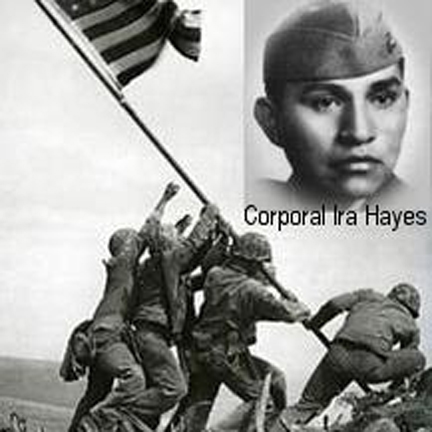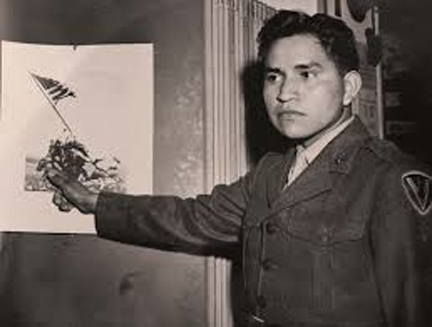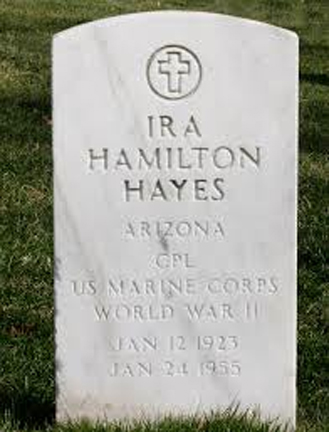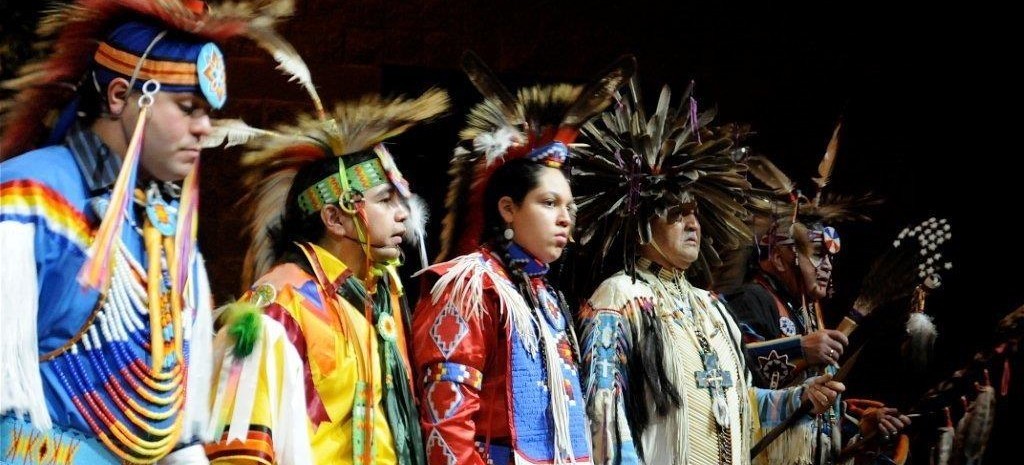 You’ve most likely seen this photo before, and you may also know the young man inside the insert is none other than United States Marine Corporal Ira Hamilton Hayes. He’s the guy on the far left standing up the flag. He is also known as Chief Falling Cloud and was also an enrolled member of the Gila River Pima Indian Reservation.
You’ve most likely seen this photo before, and you may also know the young man inside the insert is none other than United States Marine Corporal Ira Hamilton Hayes. He’s the guy on the far left standing up the flag. He is also known as Chief Falling Cloud and was also an enrolled member of the Gila River Pima Indian Reservation.
Ira Hayes Not The Only Native Warrior
Ira won many awards and served as a valiant warrior with honor, but he was not alone in that pursuit. According to a government news article written by Rudi Williams, “More than 10 percent of the Native American population, or one-third of all able-bodied Indian men from 18 to 50 years of age saw service during World War II, said LeHockey, commander of the Officer Candidates School at Marine Corps Base Quantico, Va.
“In some tribes, the percentage of men in the military reached nearly 70 per cent,” he said. “Several hundred Indian women also served with the Women’s Army Corps, the Navy’s Women Accepted for Volunteer Emergency Service and Army Nurse Corps. Indian participation in World War II was so extensive that it later became part of American folklore and popular culture.”
 It also became part of Marine Corps legend, particularly the Navajo code talkers, LeHockey said. For Marines, he said, the battle for Iwo Jima was the “code talkers” finest performance. The entire invasion was directed by orders communicated in the Navajo code. During the first 48 hours, while American forces were landing and consolidating their shore positions, six code-talker networks operated around the clock, sending and receiving more than 800 critical messages without error.
It also became part of Marine Corps legend, particularly the Navajo code talkers, LeHockey said. For Marines, he said, the battle for Iwo Jima was the “code talkers” finest performance. The entire invasion was directed by orders communicated in the Navajo code. During the first 48 hours, while American forces were landing and consolidating their shore positions, six code-talker networks operated around the clock, sending and receiving more than 800 critical messages without error.
Without Native American Indians, World War II Might Not Have Been Won
“The communications officer for the Fifth Marine Division said, ‘without the Navajos, the Marines never would have taken Iwo Jima,'” LeHockey said. “He could have just as easily said, ‘without Native American Indians, World War II might not have been won . . . ,’ because not incidentally, one of those flag raisers at Iwo was a Pima Indian named Ira Hamilton Hayes.”
It took more than 30 years for the Navajo code talkers to be recognized for their contributions to victory during World War II. It also took more than 30 years for Native Americans to be honored with a national memorial, LeHockey noted.
On Nov. 1, 1986, “the first national memorial honoring Native American veterans was dedicated at Arlington National Cemetery near the grave of Ira Hayes,” the colonel noted. “At the base of the memorial, a cottonwood tree was planted as a living memorial to those who served. A bronze plaque reads, “Dedicated to our Indian warriors and their brothers who have served us so well . . . the Vietnam Era Veterans . . . we are honored to remember you . . . .”
John Cash wrote a ballad of Ira Hayes and several films have immortalized him, most missing the important aspects of who he was as a Native warrior. Most certainly he suffered from PTSD following the war, mourning over the friends who didn’t make it back while he was being honored. You can find out more about that at Wikipedia.
November 10, 1993 Marine Corps Commemoration
During a United States Marine Corps ceremony at the Marine Corps War Memorial (Iwo Jima Memorial) commemorating the 218th anniversary of the Marine Corps. Of Ira Hayes, USMC Commandant General Carl Mundy said:
 “One of the pairs of hands that you see outstretched to raise our National flag on the battle-scarred crest of Mount Suribachi so many years ago, are those of a Native American … Ira Hayes … a Marine not of the ethnic majority of our population.
“One of the pairs of hands that you see outstretched to raise our National flag on the battle-scarred crest of Mount Suribachi so many years ago, are those of a Native American … Ira Hayes … a Marine not of the ethnic majority of our population.
“Were Ira Hayes here today … I would tell him that although my words on another occasion have given the impression that I believe some Marines … because of their color … are not as capable as other Marines … that those were not the thoughts of my mind … and that they are not the thoughts of my heart.
“I would tell Ira Hayes that our Corps is what we are because we are of the people of America … the people of the broad, strong, ethnic fabric that is our nation. And last, I would tell him that in the future, that fabric will broaden and strengthen in every category to make our Corps even stronger … even of greater utility to our nation. That’s a commitment of this commandant … And that’s a personal commitment of this Marine.”
Apologies Too Late
Like for most Native Warriors, apologies came too late for Hayes. He died in 1953, most likely from affects of PTSD which led him to drinking. Here at Restoring the Heart we are glad for the apology, and we hope to see this more of this open and current honoring and restoration. We pray to Creator Yahweh for this very thing. One Native Marine worked hard to help do this very thing by creating a Native American Powwow to Honor Veterans.
Thank you Ira Hayes. You served your country and your people well. Pleya gi. Go with blessings.
For more information on how the Navajo Code Talkers got started, click here.
The following is an excerpt from the above article:
Why Navajo?
The idea to use Navajo for secure communications came from Philip Johnston, the son of a missionary to the Navajos and one of the few non-Navajos who spoke their language fluently. Johnston, reared on the Navajo reservation, was a World War I veteran who knew of the military’s search for a code that would withstand all attempts to decipher it. He also knew that Native American languages—notably Choctaw—had been used in World War I to encode messages.
Johnston believed Navajo answered the military requirement for an undecipherable code because Navajo is an unwritten language of extreme complexity. Its syntax and tonal qualities, not to mention dialects, make it unintelligible to anyone without extensive exposure and training. It has no alphabet or symbols, and is spoken only on the Navajo lands of the American Southwest.
